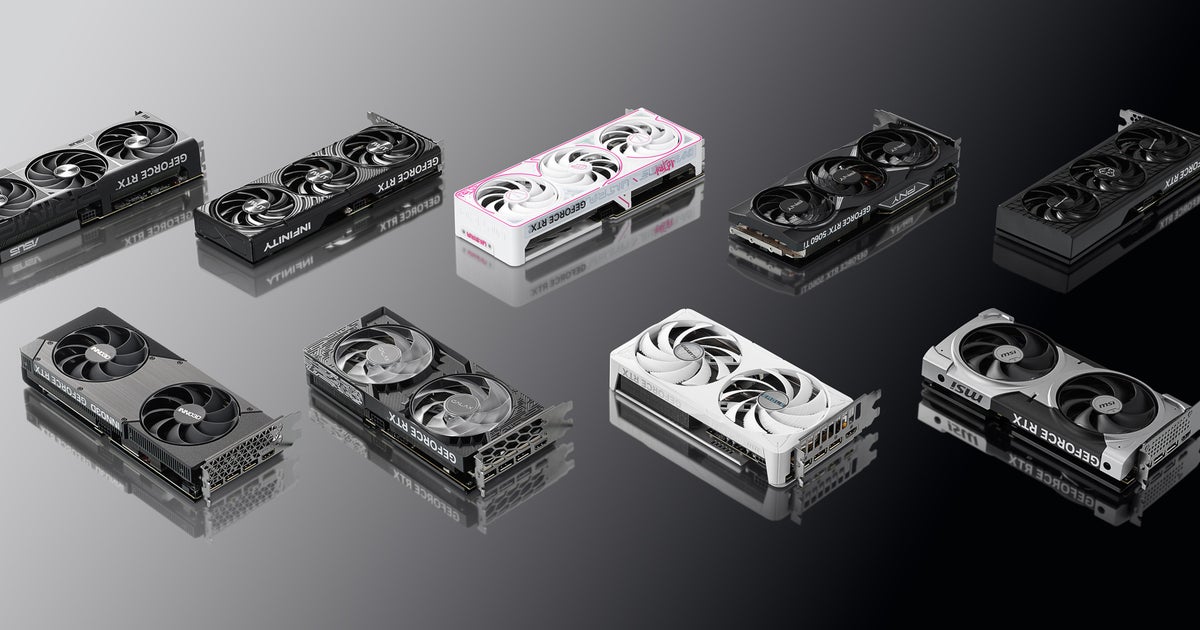Months after the arrival of the flagship RTX 5090, Nvidia has finally announced its three mainstream RTX 50-series GPUs: the RTX 5060 Ti 16GB, RTX 5060 Ti 8GB and RTX 5060.
The two RTX 5060 Ti graphics card models are set to arrive on April 16th – tomorrow! – with a nominal retail price of $379 for the 8GB card and $429 for the more desirable 16GB variant.
Given the paucity of RRP cards in the rest of the Blackwell line-up, it’s likely that we’ll see many models sold above this price – irrelevant of the presence or absence of value-adds like factory overclocks, improved thermal solutions or compact SFF-friendly designs. Some of the partner designs are shown above, including models from Asus, Inno3D, Palit, Galax, Colorful, Gigabyte, MSI and Gainward.
The RTX 5060, meanwhile, is scheduled to debut sometime in May for $299. With just an $80 gap between the 5060 and 5060 Ti 8GB – and a further $50 swing to the 16GB model – it’ll be interesting to see how these three models compare in terms of performance.
Looking at the specifications, it’s surprising to see Nvidia launch a $379 GPU with just 8GB of video memory in the year of our lord 2025. While most games can be tweaked to perform well with this level of available VRAM, we are continuing to see new PC releases – particularly PS5 ports – that launch with extremely poor performance on 8GB GPUs. In fact, the RTX 3060, which debuted with 12GB of frame buffer memory, is sometimes capable of outdueling the RTX 4060 8GB, and I’d hate to see that situation repeated with the RTX 5060.
Elsewhere, the spec sheets are as expected. The 5060 Ti uses the GB206 GPU with 4608 cores, which is cut back for the 5060 to just 3840 cores – or 80 percent of the total. Boost clocks remain around the 2.5GHz mark, as we’ve seen with most other cards in the line-up, and TGPs range from 180W on the Ti to 150W on the vanilla 5060, allowing you to get away with a meagre 450W PSU. Note that due to the 128-bit memory bus, memory bandwidth is 448GB/s for all three models.
| RTX 5070 Ti | RTX 5070 | RTX 5060 Ti | RTX 5060 | |
|---|---|---|---|---|
| Processor | GB203 | GB205 | GB206 | GB206 |
| Cores | 8,960 | 6,144 | 4,608 | 3,840 |
| Boost Clock | 2.45GHz | 2.51GHz | 2.57GHz | 2.50GHz |
| Memory | 16GB GDDR7 | 12GB GDDR7 | 16GB GDDR7 8GB GDDR7 |
8GB GDDR7 |
| Memory Bus Width | 256-bit | 192-bit | 128-bit | 128-bit |
| Memory Bandwidth | 896GB/s | 672GB/s | 448GB/s | 448GB/s |
| Total Graphics Power | 300W | 250W | 180W | 150W |
| PSU Recommendation | 750W | 650W | 450W | 450W |
| Price | $749/£729 | $549/£539 | $429 $379 |
$299 |
| Release Date | February 20th | March 5th | April 16th | May |
With the advantages of DLSS 4 multi frame generation becoming less obvious at lower base frame-rates, and relatively meagre gen-on-gen performance increases this generation outside of the RTX 5090, it’ll be fascinating to see whether the new XX60 cards will be able to meaningfully distinguish themselves from the RTX 40-series cards they are meant to replace. If the performance gap remains in the 10-15 percent range, for example, I could see discounted RTX 4060 or 4060 Ti cards being a popular option – not to mention AMD’s RX 7700 XT or rumoured RX 9060 XT.
Sadly, we don’t get too much of an indication of expected performance from Nvidia’s press materials, which uses 4x frame generation wherever possible. The one game that doesn’t support frame generation, Delta Force, seems to show ~105fps for the 3060 Ti, ~110fps for the 4060 Ti and ~130fps for the 5060 Ti – which would work out to an 18 percentage point advantage gen-on-gen from the new card.
It’s a similar story with the RTX 4060, 4060 and 5060, with the Delta Force graph showing average frame-rate figures of around ~120fps, ~140fps and ~160fps respectively – or around a 14 percent for the 5060 versus its immediate predecessor.
We don’t have too long until the RTX 5060 Ti arrives with users, so stay tuned for reviews.
